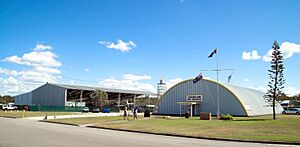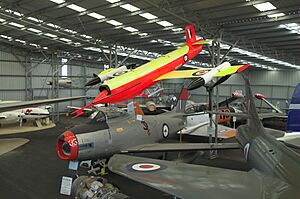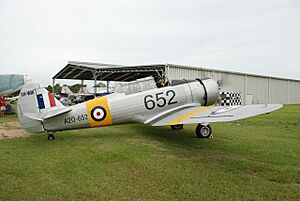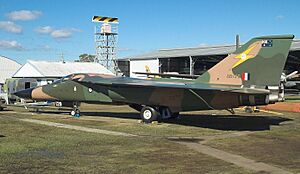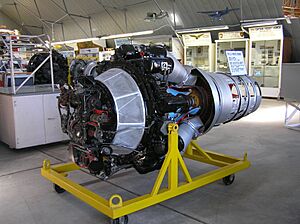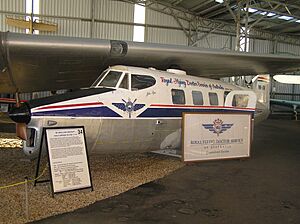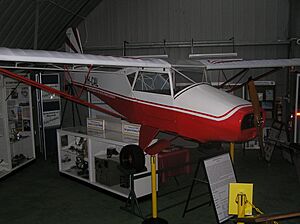Queensland Air Museum facts for kids
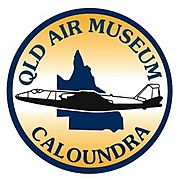 |
|
| Established | 1974 |
|---|---|
| Location | 7 Pathfinder Drive, Caloundra, Sunshine Coast, Queensland |
| Type | Aerospace museum |
The Queensland Air Museum is a super cool place in Caloundra, Queensland, Australia. It's a special museum run by volunteers who love planes! Their main goal is to collect and keep safe all kinds of aviation history, especially things from Australia and Queensland. They want to share these amazing stories with everyone.
This museum has the biggest and most varied collection of old aircraft in Australia. They also have lots of aircraft engines, equipment, photos, uniforms, and books. In 2025, about 185 amazing volunteers helped run the museum. They spent over 38,000 hours making sure everything was perfect!
Contents
History
The Queensland Air Museum first opened its doors on June 2, 1974. The very first aircraft they showed was a big Canberra bomber plane. Volunteers carefully moved this plane from an air force base to a park in Brisbane.
Over time, the museum's collection grew. They got a Meteor plane from the British Government. They also added a Vampire and two Sea Venoms.
Because a new airport was being built nearby, the museum had to move its collection. After some challenges, they found a new, permanent home on the Sunshine Coast. On June 14, 1986, all the planes were moved to a spot next to Caloundra Aerodrome. A brand new hangar was built for them!
The museum officially opened on April 4, 1987. It was opened by Mrs. Ly Bennett, whose husband, Air Vice-Marshal Don Bennett, was a famous pilot from World War II. He led a special group called the Pathfinder Force. To honor him, the road in front of the museum was named Pathfinder Drive.
With a permanent home, the collection kept growing. In 1989, the museum even went on an exciting trip to Singapore! They bought a Sea Vixen, a Meteor, and a Hunter from a scrap metal dealer. They saved these planes just days before they were going to be destroyed! The planes were taken apart, shipped to Australia, and then put back together for display.
The museum site is about two hectares big. Over the years, they built a second hangar, which was finished in 2004 and made even bigger in 2006. They also built a library, workshops for fixing planes, and storage areas.
For many years, there was talk about moving Caloundra Aerodrome, which made the museum's future uncertain. But on September 2, 2010, the Queensland Premier announced that the airport would stay right where it was. This was great news for the museum! The local council then gave the museum a 30-year lease extension. This meant the museum could keep sharing its amazing planes for a long time.
In 2024, the museum celebrated 50 years of being open! They made a big plan for the future to make sure their collection stays safe and sound for the next 50 years. This plan includes building new, climate-controlled areas for the planes, the volunteers, and the 25,000 visitors who come each year.
Aircraft Collection
The museum has a huge collection of aircraft. These planes show many different parts of aviation history.
You can see military aircraft from the Royal Australian Air Force (RAAF), Royal Australian Navy (RAN), and even other countries like the UK and Singapore. There are also passenger planes from famous Australian airlines like Ansett Airlines and Trans Australia Airlines.
The museum also has planes designed or built right here in Australia. These include the Commonwealth Aircraft Corporation Wirraway and Winjeel, and the Government Aircraft Factories Jindivik. You can also find agricultural planes, training planes, helicopters, and naval aircraft.
Wicko Cabin Sports VH-UPW Replica
The Wicko Cabin Sports was the very first powered aircraft designed and built in Queensland. It was made of wood and fabric and first flew in January 1931. The Queensland Air Museum got copies of the original plans for this important plane. They built a perfect replica of it, which went on display in 2007.
CAC Wirraway A20-652
The Commonwealth Aircraft Corporation's Wirraway is a very important plane for Australia. It helped create a strong aircraft industry here. The Wirraway was built between 1939 and 1946. It's the second most produced aircraft type in Australia, with 755 made!
These planes were used by the RAAF in World War II for scouting, bombing, and helping the army. They were also used as advanced training planes for many years after the war.
The Wirraway at the museum was built in July 1944. The museum bought it in 2010. It was flown from Adelaide to Caloundra and is kept in working condition. You can sometimes see its engine running during special public displays!
General Dynamics F-111C A8-129
The F-111 was the RAAF's main strike aircraft for 37 years. It was used until it retired in December 2010. These planes were famous for their "dump and burn" trick. This is when they would release fuel and light it with their engines, creating a spectacular flame! It was a popular sight at air shows and events like the Brisbane River Fire.
The Queensland Air Museum has an F-111C aircraft, A8-129, on display. This plane was one of the first F-111s to arrive in Australia in 1974. It also flew in the very last operational flight of its type in 2010. One side of the plane is painted with the markings of 1 Squadron, and the other side has 6 Squadron markings.
Engine Collection
The museum has a large collection of aircraft engines. Many of them are displayed next to the planes they would power. These include different types like piston engines, turbojets, and turboprop engines.
Some of the piston engines you can see are the big radial types like the Pratt & Whitney Wasp and Twin Wasp engines. There are also famous engines like the Allison V-1710 and the Rolls-Royce Merlin.
The turbojet collection includes early designs like the de Havilland Goblin and Rolls-Royce Nene. These engines helped planes fly much faster!
The museum also has an "Operational Engine Collection." These are engines that are mounted on special stands and can actually be run during public displays. You can hear and see them working! They range from small 40 horsepower engines to powerful 1,450 horsepower radial engines.
Displays
The museum has many displays that tell the story of aviation in Australia, Queensland, and the local Sunshine Coast. These displays cover interesting topics like Charles Kingsford Smith, Women in Aviation, the Pathfinder Force, the Korean War, and the Vietnam War. You can also learn about famous airlines like Ansett Airlines and Qantas, and important services like the Royal Flying Doctor Service.
Royal Flying Doctor Service
The Royal Flying Doctor Service (RFDS) is super important for people living in remote parts of Australia. It provides medical help to isolated communities. This amazing service was started by Reverend John Flynn on May 15, 1928.
Flynn had a brilliant idea: use radios and planes to connect doctors with patients in faraway places. He worked with Alfred Traeger to create special two-way radios that used a pedal to generate power. The service began with a de Havilland DH-50 aircraft. Today, the RFDS still operates over 60 aircraft across Australia!
The Queensland Air Museum's RFDS display includes a DHA-3 Drover aircraft that was used by the service. You can also see an example of a Traeger radio. The Drover planes at the museum were used by the Queensland section of the RFDS between 1951 and 1968.
Calair Skyfox
The museum has a special display about a local aircraft maker called Calair Corp / Skyfox Aviation. The main part of this display is a CA21 Skyfox aircraft. This plane was put together using parts from several Skyfox aircraft.
Calair Corporation started in 1989 at Caloundra Airport. They wanted to build a two-seat plane called the Calair CA21 Skyfox. It was designed for training and fun flying. This plane was the first in Australia to be approved for general aviation pilot training. It used a 2.1-liter engine. About 33 of these CA21 planes were made between 1990 and 1991.
In 1991, the company changed its name to Skyfox Aviation Ltd. They then started making the CA22 model, which had many improvements. Later, they made the CA25, and then the CA25N Gazelle. This last model had a different landing gear, which was better for pilot training. About 66 Gazelle planes were made before the company stopped production in 1998.
Pathfinder Force
During World War II, British bombers flew at night to bomb targets in Germany. It was very hard to hit the targets accurately. So, in 1942, the Pathfinder Force was created to help! It was led by Group Captain Don Bennett, who was born in Queensland.
The Pathfinder Force had special squadrons with experienced crews. Their job was to fly ahead of the main bomber force. They would find the target and mark it with bright flares. This helped the bombers coming behind them drop their bombs in the right place, making their missions much more successful.
To remember the Pathfinder Force, the museum has a large display. It includes uniforms, special items, models, and even a copy of Don Bennett's office. This office has many of his original belongings! The display is located near the F-111 strike aircraft, showing a link between old and modern air forces.
Aircraft on display
As of January 2024, here are some of the amazing aircraft you can see at the museum:
- Auster J/5G Autocar, VH-BYP
- Auster J/5B Autocar, VH-KCL
- Avions Max Holste MH.1521M Broussard, VH-HFA
- Anson Mk 1, VH-BIF
- Anson Mk 1, MG222
- Beagle B.206-S, VH-UNL
- Beech C18S, VH-CLG
- Beech E18S, N3781B
- Beech P35 Bonanza, VH-AWC
- Beech 65 Queen Air, VH-FDV
- Beech 200 Super King Air, VH-FII
- Beech 2000A Starship, N786BP
- Bell UH-1H Iroquois, A2-310, Australian Army
- Bell 206B-1 Kiowa, A17-012, Australian Army
- Bensen B-8M Gyrocopter
- Bristol Bloodhound Mk.I
- Bristol Scout D, 8976, AFC (replica)
- Broome Lebeau, 10-0046
- Calair CA21 Skyfox, VH-CAL
- Cessna 336 Skymaster, VH-CMY, ANSETT-MAL
- Cessna 402A, VH-DZY, Bush Pilots Airways
- Chrislea CH.3 Super Ace, VH-BRO
- Commonwealth Aircraft Corporation CA-6 Wackett KS-3 Cropmaster, VH-AJH
- Commonwealth Aircraft Corporation CA-16 Wirraway Mk.III, A20-652, RAAF
- Commonwealth Aircraft Corporation CA-18 Mustang Mk. 23, A68-201, RAAF (replica)
- Commonwealth Aircraft Corporation CA-25 Winjeel, A85-410, RAAF
- Commonwealth Aircraft Corporation CA-27 Sabre Mk.31, A94-935, RAAF
- Commonwealth Aircraft Corporation CA-28 Ceres, VH-CEU, cockpit only
- de Havilland DH-82A Tiger Moth, VH-BKS
- de Havilland DH-100 Vampire F Mk.30, A79-476, RAAF
- de Havilland DH-104 Dove Mk.1, VH-MAL Rai, Mandated Airlines
- de Havilland DH-112 Sea Venom FAW Mk.53, WZ898, RAN
- de Havilland DH-112 Sea Venom FAW Mk.53, WZ910, RAN (stored)
- de Havilland DH-110 Sea Vixen FAW Mk.2, XJ490, RN
- de Havilland DH-110 Sea Vixen FAW Mk.2, XJ607, RN (nose section)
- de Havilland DH-114 Heron 2D/A1, VH-KAM, Airlines of Tasmania
- de Havilland DH-115 Vampire T Mk. 35A, A79-828, RAAF
- de Havilland DHA-3 Drover Mk.3, VH-FDR John Flynn, Royal Flying Doctor Service
- de Havilland DHA-3 Drover Mk.3, VH-FDS Norman Bourke, Royal Flying Doctor Service
- de Havilland Canada DHC-1 Chipmunk T Mk.10, VH-RVV, Royal Victorian Aero Club
- de Havilland Canada DHC-4 Caribou, A4-173, RAAF
- de Havilland Canada DHC-4 Caribou, A4-159, RAAF (nose section)
- Douglas DC-3-194B, VH-ANR, Ansett Airlines of NSW
- Fairey Gannet AS Mk.1, XA331, RAN
- Fokker F.27 Friendship Mk.400, VH-FNQ, Ansett Airlines
- General Dynamics F-111C, A8-129, RAAF
- Government Aircraft Factories Canberra B Mk.20, A84-225, RAAF
- Government Aircraft Factories Jindivik Mk.3B, WRE-601
- Government Aircraft Factories Mirage IIIO(FA), A3-16
- Government Aircraft Factories N22B Nomad, VH-BFH
- Government Aircraft Factories Turana, P1-019
- Gloster Meteor F Mk.8, WA880, RAF (painted as RAAF A77-721)
- Armstrong Whitworth Meteor TT Mk. 20, WD647, RAF
- Grumman S-2A Tracker, 133160
- Hawker Hunter F Mk.4, XF311, RAF
- Hawker Hunter FGA Mk. 74BS, 533, Republic of Singapore Air Force
- ICA-Brasov IS-28M, VH-GRK
- ICA-Brasov IS-29D, VH-GWC
- International Model Aircraft Towed Glider Mk.2, Identity unknown
- Kawasaki KH-4, VH-AHQ
- Kawasaki KH-4, VH-HFZ
- Lake LA-4-200 Buccaneer, VH-EJX
- Lea Kestrel Kermit, 10-001
- Link Trainer D4-282
- Lockheed PV-1 Ventura, A59-96, RAAF
- Lockheed SP-2H Neptune, A89-277, RAAF
- Lockheed AP-3C Orion, A89-760, RAAF
- Mohawk 298, VH-HIX, Queensland Pacific Airways
- Piaggio P.166, VH-BHK, (painted as Queensland Airlines VH-PQA)
- Pilatus PC-6 Porter, A14-705, Australian Army (nose section only)
- Piper PA23-250 Aztec, VH-MBX, (painted as TAA Sunbird Services VH-TGP)
- Piper PA25-235 Pawnee, ZK-CEL
- Piper PA38-112 Tomahawk, VH-SCK
- Pterodactyl Ascender II+, 10-0665
- Rand Robinson KR-2, VH-XXS
- Robinson R22 Beta, VH-SBQ
- Robinson R44 Raven, VH-RMN (cockpit only)
- Seabird Rouseabout Mk. 3, 10-0281
- Seabird Sentinel, VH-SBI
- Seabird Sentinel, VH-SBU
- Sports Flight Skypup, (identity unknown)
- Sud-Ouest SO-1221S Djinn, VH-INP, Ansett-ANA
- Aerospatiale SA315B Lama, PK-ZHB
- Swearingen SA-226 Metroliner II, VH-BPV, Bush Pilots Airways
- Transavia PL-12 Airtruk, ZK-CWX
- Vickers Viscount 756D, VH-TVJ, Trans-Australia Airlines (nose section)
- Victa Airtourer 100, VH-CFE
- Westland Wessex HAS MK.31A, N7-217, RAN
- Wicko Cabin Sports, VH-UPW, (replica)
- Winton Grasshopper, (identity unknown)
- WSK Mielec SB Lim-2, 636, Polish Air Force
See also
- List of aerospace museums


